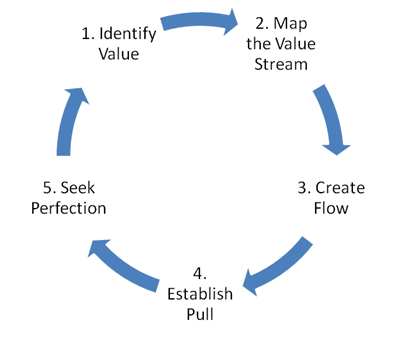Over the years, research — as well as trial and error — led to what is now called lean manufacturing.
The five-step thought process for guiding the implementation of lean techniques is easy to remember, but not always easy to achieve:
- Specify value from the standpoint of the end customer by product family.
- Identify all the steps in the value stream for each product family, eliminating whenever possible those steps that do not create value.
- Make the value-creating steps occur in tight sequence so the product will flow smoothly toward the customer.
- As flow is introduced, let customers pull value from the next upstream activity.
- As value is specified, value streams are identified, wasted steps are removed, and flow and pull are introduced, begin the process again and continue it until a state of perfection is reached in which perfect value is created with no waste.

A Brief History of Lean Manufacturing
Henry Ford was one of the first people to develop the ideas behind Lean Manufacturing. He used the idea of "continuous flow" on the assembly line for his Model T automobile, where he kept production standards extremely tight, so each stage of the process fitted together with each other stage, perfectly. This resulted in little waste.
But Ford's process wasn't flexible. His assembly lines produced the same thing, again and again, and the process didn't easily allow for any modifications or changes to the end product – a Model T assembly line produced only the Model T. It was also a "push" process, where Ford set the level of production, instead of a "pull" process led by consumer demand. This led to large inventories of unsold automobiles, ultimately resulting in lots of wasted money.
Other manufacturers began to use Ford's ideas, but many realized that the inflexibility of his system was a problem. Taiichi Ohno of Toyota then developed the Toyota Production System (TPS), which used Just In Time manufacturing methods to increase efficiency. As Womack reported in his book, Toyota used this process successfully and, as a result, eventually emerged as one the most profitable manufacturing companies in the world.
Toyota based lean manufacturing is based on two basic concepts.
The first, known as Jidoka, states that quality has to be an inherent part of the overall process. Reviewing items at the end of the production line isn't the most efficient way to deliver quality products to consumers.
The second component called Just-in-Time, which is a supply and demand idea that states materials and products should be made only when needed.
Just-in-Time reduces cost and waste associated with inventory backlogs.
The Seven Wastes
Taichi Ohno, former Toyota Chief Engineer, identified 7 wastes of manufacturing:
-
Overproduction
-
Transportation
-
Unnecessary Inventory
-
Inappropriate Processing
-
Waiting
-
Excess Motion
-
Defects
These wastes should not be considered separate categories; instead, we should use these wastes as a teaching/learning tool to help identify opportunities to improve our work environment and focus on adding value for the customer. Wastes are non-value-added activities for which the customer would not be willing to pay.
Mobile workstation carts with power are at the very core of reducing waste.
Learn how Magneti Marelli Powertrain USA, an international leader in the design and production of high-tech component systems and modules for the automotive, surface vehicle and marine industries improved the accuracy of shipments by integrating PC Series Workstations into the workplace. Download the case study here.











